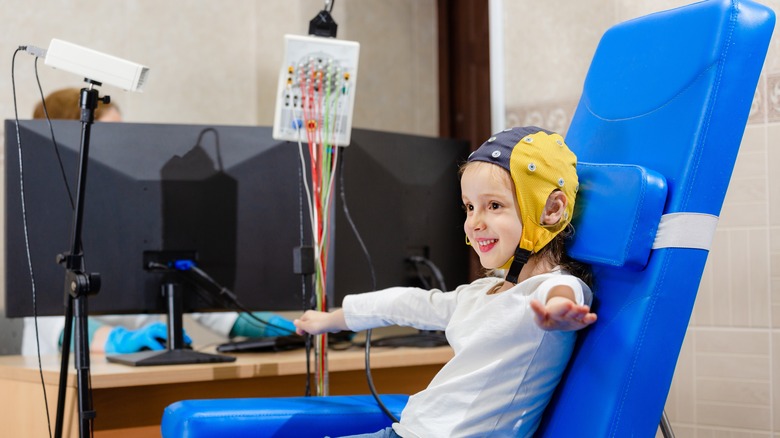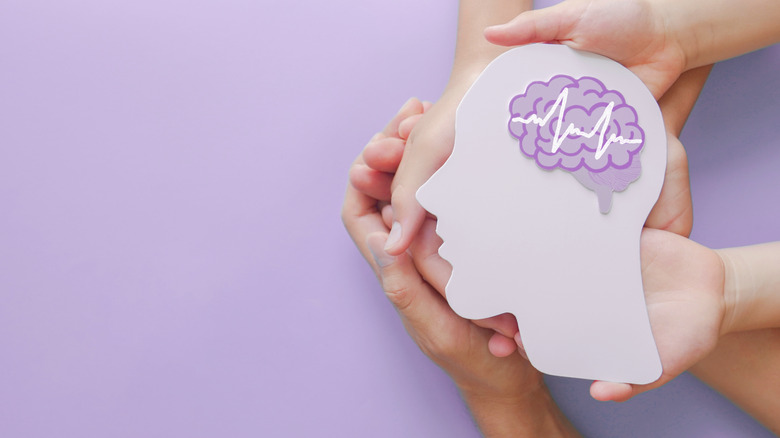Health Benefits Of Biofeedback Therapy
Biofeedback is a treatment technique that uses non-invasive bio-monitoring sensors attached to the body to measure body functions, providing essential feedback or information that helps address certain health concerns (via Healthline). According to Johns Hopkins Medicine, it's similar to the old idea of controlling the body with the mind, which has fueled most Eastern philosophies, like yoga and meditation. However, as a modernized version, biofeedback therapy uses multiple scientific instruments to diagnose and reveal the level of control you may have in real-time.
There are three types of biofeedback: electromyography (EMG), thermal, and neurofeedback or electroencephalography (EEG), as per Medical News Today. Each method measures different indicators. EMG measures muscle tension, thermal biofeedback measures body temperature changes, and EEG centers around brain waves. The procedure and sessions required are based on your specific medical condition. Sessions usually last no more than one hour, and some people may see positive effects after eight to 10 sessions. However, people with conditions, like high blood pressure, might require 20 sessions. You might also be given additional relaxation activities to perform at home for five to 10 minutes daily.
It may treat epilepsy
Biofeedback therapy has grown in popularity, gaining approval from the American Health Care Policy Review after reviewing the treatment's effects on managing conditions, such as epilepsy, which are difficult to treat (per WebMD). Epilepsy is a neurological disorder where electrical activity in the brain can trigger seizures, according to the World Health Organization. In fact, around 10% percent of people have a single seizure during their lifetime. However, people with epilepsy have at least two or more unprovoked seizures.
Fortunately, neurofeedback can help train the brain to de-emphasize rhythms that cause seizures, as per a 2005 study published in the journal Child and Adolescent Psychiatric Clinics of North America. Additionally, recent improvements in the therapy have made it possible to reduce a person's reliance on anti-seizure medications or to entirely eliminate seizures altogether. Another 2018 study published in the journal eBioMedicine reiterates this claim, supporting the reduction in the frequency of epileptic seizures due to biofeedback therapy.
Reduces ADHD symptoms
Attention deficit hyperactivity disorder (ADHD) is a condition that causes impulsive and hyperactive behavior, per the National Health Service (NHS). While most cases of ADHD are diagnosed in childhood, some adults are also diagnosed with it. Luckily, neurofeedback is a viable alternative for ADHD, according to the American Psychological Association. Supporters of the treatment believe that neurofeedback can train the brain to reduce theta waves and increase beta waves, ultimately reducing ADHD symptoms, per the Children and Adults with Attention Deficit/Hyperactivity Disorder Organization (CHADD).
During the treatment, EEG sensors are placed in the patient's head to monitor brain activity, explains WebMD. The patient usually undertakes an activity, such as playing a game, using their brain. The sensors then identify and report brain waves via a screen, indicating that the patient is concentrating, triggering a reward signal, such as a bell. The therapy aims to help your child understand what it feels like to concentrate and help reduce ADHD symptoms.
It can help manage anxiety
According to Mayo Clinic, biofeedback is used to help manage physical and mental health issues, such as anxiety. The American Psychiatric Association says anxiety disorder is characterized by excessive fear and is a common mental health condition that affects nearly 30% of adults in their lifetime. If you have a general anxiety disorder, you are always waiting for a disaster to strike, making daily life feel like a constant state of worry or fear (via the National Institute of Mental Health).
Fortunately, this condition is treatable, and biofeedback can be a viable option, according to the Psychiatric Times. The treatment of psychological disorders, such as anxiety and insomnia, with biofeedback, has been well-documented and appears to be highly effective. In addition, biofeedback appears to be valuable for the treatment of generalized anxiety disorder during hyperarousal reduction training. Luckily, it can also be effective in reducing fearful anticipation triggers.
Aids with urinary incontinence
The National Institute of Aging defines urinary incontinence as a condition that makes you accidentally leak urine. This condition can be embarrassing, preventing you from undertaking normal daily activities. According to Medical News Today, biofeedback can also assist with urinary incontinence. However, the U.S. Department of Health & Human Services recommends biofeedback therapy be taken alongside pelvic floor muscle training.
Using biofeedback therapy to treat incontinence involves adding two small sensors in the anus area and another set of sensors on the abdomen, per the University of California San Francisco Health (UCSF). The treatment usually targets muscles controlled by the autonomic nervous system, which manages defecation and urination, per a 2022 study published in the journal StatPearls. Pelvic floor muscles are usually the focus for urinary incontinence, and the external anal sphincter is the target for fecal incontinence. Overall, the procedure normally features a computerized graph that ensures you train the right muscles in your biofeedback therapy fitness plan (via UCSF Health).
It could help with headaches
Migraines are a type of headache that can lead to pulsating or throbbing sensations (via the Mayo Clinic). According to the National Health Service, migraines affect about one in five women and 1 in 15 men. They often begin during early adulthood and can significantly affect a person's quality of life. While there's no cure for this neurological condition, biofeedback has promising results in reducing migraine frequency and severity, per Healthline.
As a treatment option, biofeedback helps keep track of your bodily response to stress so you can become increasingly aware of them and learn how to relax under stressful situations. The ultimate aim is to reduce the severity of stress-related migraines. According to the American Migraine Foundation, relaxation training and biofeedback might help reduce the severity and frequency of headaches by 45% to 60%. This efficacy level is at par with several other effective medications, like propranolol. Still, the added perk of zero side effects attached to biofeedback makes it more viable for migraine patients.
Although biofeedback also seems promising for many other conditions, like back pain, there is still much to be learned about the potential of the therapy. In fact, there may be some significant cautions limiting biofeedback from going fully mainstream, per Harvard University. Therefore, while biofeedback may be a good option for some, medications can't be dismissed, it's always best to speak with a health expert if you're unsure whether the treatment will be effective for you.






